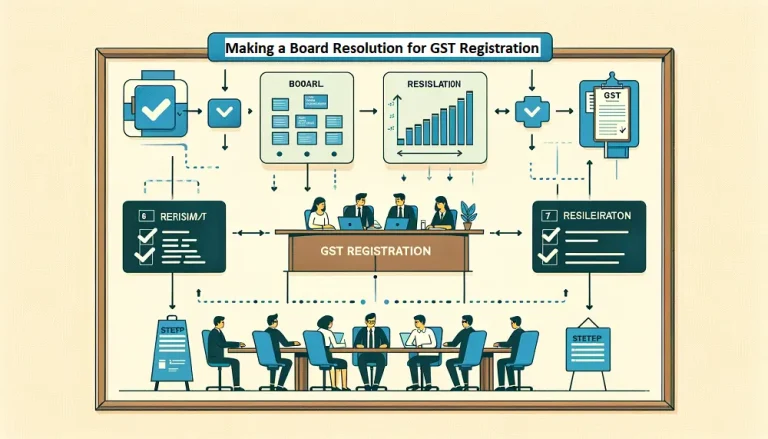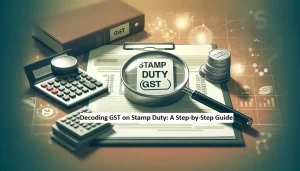Registering for Goods and Services Tax (GST) is an essential step for businesses in India. This step not only ensures compliance with the law but also boosts the credibility of a business and opens up broader opportunities. One important part of the GST registration process, especially for companies, is creating a Board Resolution for GST Registration. This document records the formal decision of the company’s board to register for GST. Here is a comprehensive and detailed guide to understanding and creating a board resolution for GST registration.
What is a Board Resolution for GST Registration?
A board resolution is an official document that captures the decisions made by a company’s board of directors during a meeting. When it comes to GST registration, a board resolution is a formal document that shows the decision of the board to authorize a specific person or persons to handle the GST registration process on behalf of the company. This document is very important because it provides legal authorization and serves as a clear record of the company’s intent and actions.
Why is a Board Resolution Required for GST Registration?
The need for a board resolution for GST registration arises from the necessity for formal and documented authorization within a company. Here are several reasons why this document is essential:
Legal Compliance: It ensures that the GST registration process adheres to the company’s internal governance policies and legal requirements, thus preventing any potential legal issues.
Authorization: It explicitly designates a specific individual or group of individuals who are responsible for managing the GST registration process, ensuring clarity and accountability within the organization.
Documentation: It provides a written record of the board’s decision, which can be referred to in the future if needed for verification or auditing purposes.
Banking and Financial Transactions: Financial institutions and banks often require a board resolution to open GST-related accounts or conduct transactions related to GST, ensuring that the process is handled by authorized personnel.
Key Components of a Board Resolution for GST Registration
Creating a board resolution for GST registration involves several crucial components, each serving a specific purpose to ensure the document’s effectiveness. Here’s a detailed breakdown of each part:
Title: The title should clearly indicate that the document is a board resolution for GST registration. This ensures that the purpose of the document is immediately apparent.
Date and Place: The document should include the date and location of the board meeting where the resolution was passed. This provides a time frame for the decision.
Introduction: A brief introduction explaining the purpose of the resolution is essential. It sets the context for the decision being recorded.
Authorization Clause: This clause explicitly states that the board authorizes a specific person or persons to apply for GST registration on behalf of the company.
Authority Details: This section should provide details about the person(s) authorized, including their names, designations, and contact information.
Resolution Text: The main body of the resolution should detail the decision and its implications, providing a clear description of the authorization and responsibilities given.
Signatures: The document should include the signatures of the board members who were present at the meeting, validating the decision.
Company Seal: If applicable, the company’s official seal should be affixed to the document to provide further authenticity.
Drafting a Board Resolution for GST Registration: Step-by-Step Guide
Drafting a board resolution can seem complicated, but it becomes more manageable when broken down into steps. Here’s a step-by-step guide to help you draft an effective board resolution for GST registration:
Step 1: Title and Heading
Begin with a clear and concise title and heading, such as:
Board Resolution for GST Registration
Step 2: Date and Place
Include the date and place of the board meeting. For example:
Date: [Insert Date]
Place: [Insert Place]
Step 3: Introduction
Provide a brief introduction that explains the purpose of the resolution. For example:
Introduction
This board resolution is made to authorize [Name/Designation] to apply for GST registration on behalf of [Company Name].
Step 4: Authorization Clause
Draft the authorization clause to clearly state the board’s decision. For instance:
Authorization Clause
Resolved that [Name/Designation] is hereby authorized to apply for Goods and Services Tax (GST) registration on behalf of [Company Name], and to sign and submit all necessary documents and forms required for the registration process.
Step 5: Authority Details
Include the details of the authorized person(s), such as:
Authority Details
Authorized Person: [Name]
Designation: [Position]
Contact Information: [Phone/Email]
Step 6: Resolution Text
Provide the main body of the resolution, detailing the decision and its implications. For example:
Resolution Text
Resolved that the board of directors of [Company Name] authorizes [Name/Designation] to handle the GST registration process, including but not limited to, signing and submitting necessary documents, responding to queries from the GST department, and performing all acts required to complete the registration process.
Step 7: Signature and Company Seal
Conclude the resolution with the signatures of the board members and the company seal, if applicable:
Signatures
[Board Member 1 Name and Signature]
[Board Member 2 Name and Signature]
[Board Member 3 Name and Signature]
Company Seal
[Company Seal]
Sample Board Resolution for GST Registration
Here is a sample board resolution for GST registration to provide a clear idea of how the final document should look:
Board Resolution for GST Registration
Date: [Insert Date]
Place: [Insert Place]
Introduction
This board resolution is made to authorize [Name/Designation] to apply for GST registration on behalf of [Company Name].
Authorization Clause
Resolved that [Name/Designation] is hereby authorized to apply for Goods and Services Tax (GST) registration on behalf of [Company Name], and to sign and submit all necessary documents and forms required for the registration process.
Authority Details
Authorized Person: [Name]
Designation: [Position]
Contact Information: [Phone/Email]
Resolution Text
Resolved that the board of directors of [Company Name] authorizes [Name/Designation] to handle the GST registration process, including but not limited to, signing and submitting necessary documents, responding to queries from the GST department, and performing all acts required to complete the registration process.
Signatures
[Board Member 1 Name and Signature]
[Board Member 2 Name and Signature]
[Board Member 3 Name and Signature]
Company Seal
[Company Seal]
Important Considerations While Drafting a Board Resolution
When drafting a board resolution for GST registration, there are several important considerations to keep in mind to ensure the document is effective and legally sound:
Clarity and Precision: The language used in the resolution should be clear and precise to avoid any confusion or ambiguity. Each term and clause should be straightforward.
Compliance with Company Policies: Ensure that the resolution complies with the company’s internal policies and the requirements of the Companies Act, 2013. This helps in avoiding any internal conflicts or legal issues.
Legal Review: It might be prudent to have the resolution reviewed by legal counsel to ensure it meets all legal requirements and is correctly formatted.
Timely Documentation: Make sure that the resolution is documented and signed promptly to avoid any delays in the GST registration process. Timely documentation ensures that the process can proceed without unnecessary interruptions.
Proper Storage: Store the resolution securely as it is a crucial document that might need to be referenced in the future for verification or auditing purposes. Proper storage ensures that the document remains accessible and intact.
Common Mistakes to Avoid
Creating a board resolution for GST registration involves careful attention to detail. Here are some common mistakes to avoid:
Vague Language: Avoid using vague or ambiguous language that might lead to confusion about the authorization or the responsibilities assigned.
Missing Details: Ensure all required details, such as the names and designations of the authorized persons, are included in the document. Missing details can render the resolution ineffective.
Non-compliance: Make sure the resolution complies with all relevant legal and internal company requirements to avoid any legal challenges or internal disputes.
Lack of Authorization: Ensure the resolution is signed by the required number of board members and includes the company seal if needed. Lack of proper authorization can invalidate the resolution.
Delayed Submission: Submit the resolution in a timely manner to avoid delays in the GST registration process. Delays in submission can hinder the progress of GST registration.
For a streamlined and hassle-free GST filing process, consider using GST software to simplify and ease the filing of your GST returns.
Conclusion
Creating a board resolution for GST registration is a crucial step in the GST registration process for companies. It ensures legal compliance, clear authorization, and proper documentation of the board’s decision. By following the steps outlined in this guide and paying attention to the key components and common mistakes, you can draft an effective board resolution that facilitates a smooth GST registration process. Understanding the importance and process of drafting a board resolution for GST registration can save time, avoid legal complications, and ensure a seamless transition to becoming GST-compliant. This guide provides a comprehensive framework to help you through each step of the process, ensuring that your company can meet its GST registration requirements efficiently and effectively.
Remember, a well-drafted board resolution is not just a formality but a crucial document that reflects the company’s commitment to compliance and good governance. By taking the time to draft it carefully, you can ensure that your company is well-prepared for the GST registration process.
Also Read:
- What is Goods and Service Tax (GST)?Let’s discuss Goods and Service Tax (GST). In India, GST affects most purchases or sales made. Imagine it as an added fee on everyday items we use like groceries. This is essential both to businesses as well as everyday people… Read more: What is Goods and Service Tax (GST)?
- A Simple Guide to Making a Board Resolution for GST RegistrationRegistering for Goods and Services Tax (GST) is an essential step for businesses in India. This step not only ensures compliance with the law but also boosts the credibility of a business and opens up broader opportunities. One important part… Read more: A Simple Guide to Making a Board Resolution for GST Registration
- Decoding GST on Stamp Duty: A Step-by-Step GuideUnderstanding how GST (Goods and Services Tax) and stamp duty work together can be quite challenging. Both are very important parts of the Indian taxation system and have a significant impact on various financial transactions, especially in the real estate… Read more: Decoding GST on Stamp Duty: A Step-by-Step Guide
- The ABCs of Account Accounting & Inventory System with GST ComplianceIn today’s fast-paced business world, keeping track of money and goods is crucial. That’s where an account accounting and inventory management system with GST compliance comes in. Let’s break down what it is, why it’s essential, and why using a… Read more: The ABCs of Account Accounting & Inventory System with GST Compliance
Frequently Asked Questions
What’s a Board Resolution?
A Board Resolution is a formal document that records decisions made by a company’s board of directors. It’s a crucial legal requirement for certain actions, like GST registration, showing official approval from the board.
Why is a Board Resolution needed?
It serves as evidence of the board’s authorization for significant decisions. For GST registration, it demonstrates that the company’s leadership has approved the application and its related responsibilities.
Who drafts a Board Resolution?
Typically, the company secretary or legal advisor drafts the resolution. They ensure it complies with legal requirements and accurately reflects the board’s decision regarding GST registration.
What information is included?
The resolution should state the company’s name, registration number, date, details of the decision (in this case, GST registration), and signatures of board members or their proxies.
When should a Board Resolution be made?
It’s necessary before applying for GST registration. Timing is crucial to ensure compliance and avoid delays in the registration process.
Who approves the Resolution?
The board of directors, or a designated committee if authorized, approves the resolution. Each member should understand and consent to the decision.
Can a Board Resolution be revoked?
Yes, it can be revoked or amended with the board’s agreement. However, such changes should be documented and filed accordingly.
Is a Board Resolution legally binding?
Yes, once approved and signed, a Board Resolution is legally binding. It represents the collective decision-making authority of the board.
What if a Board member dissents?
Dissenting opinions should be noted in the resolution, but the decision can still proceed if it’s approved by the majority of the board.
What happens after the Resolution?
Once finalized, the resolution should be kept in the company’s records. It will serve as proof of compliance during audits or legal inquiries regarding GST registration.








